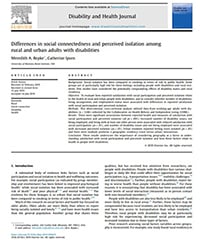RTC:Rural Researchers Publish Paper on Rural/Urban Differences in Social Connectedness and Perceived Isolation for People with Disabilities (MT UCEDD)
October 29, 2019

|
| Screenshot of the first page of journal article titled "Differences in social connectedness and perceived isolation among rural and urban adults with disabilities" |
Dr. Meredith Repke, RTC:Rural Research Associate, and Dr. Catherine Ipsen, RTC:Rural Director, recently published a paper in the Disability and Health Journal titled "Differences in social connectedness and perceived isolation among rural and urban adults with disabilities."
In the paper, Repke and Ipsen analyze survey data from the nation-wide Health Reform and Disability Survey to explore how a number of factors are related to social participation and perceived isolation for people with disabilities, and to see if there are differences for those who live in rural vs urban areas. These factors include number of disabilities, self-rated health, employment status, and living arrangements (alone or with others).
Previous studies have compared social isolation to smoking in terms of risk to public health. Some groups of people have a much higher risk of social isolation, including people with disabilities and rural residents. This research builds on previous work by considering how the potentially compounding effects of disability status and living in a rural area may affect social participation and perceived isolation.
Repke and Ipsen found that increased number of disability issues, poorer health, and not being employed were associated with reduced satisfaction with social participation.
Consistent with previous research, people reporting more disability issues were less satisfied with their social participation, and felt more isolated. There was a significant interaction between number of disability issues and geography, such that rural and urban people reported similar levels of satisfaction with social participation when they reported few disability issues, but as the number of disability issues increased, satisfaction with social participation fell more sharply for rural people. People with disabilities living in urban areas reported higher rates of perceived isolation, as compared to those living in rural areas, regardless of the number of disability issues reported.
People with disabilities living in rural and urban locations who reported better health also reported feeling more satisfied with their social participation. Being employed was also associated with more satisfaction with social participation, and less perceived isolation. The effect of being employed on satisfaction with social participation was stronger for rural people relative to urban people.
Together, these data suggest that rural people with disabilities are more at risk of feeling unsatisfied with their social participation, while urban people with disabilities are more at risk of feeling isolated. These results underscore the importance of considering people with disabilities as a unique population in their experience of satisfaction with social participation and perceived isolation. They also highlight the importance of geographical context.
Read the paper here: Differences in social connectedness and perceived isolation among rural and urban adults with disabilities
The paper uses data from the nation-wide Health Reform and Disability Survey to understand how changes in health care reimbursement strategies affect working-age people with disabilities in terms of access to health insurance, and associated health care and quality of life outcomes. RTC:Rural partnered with the Collaborative on Health Reform and Independent Living (CHRIL), who conducted the survey, to increase rural representation of survey respondents.
For more information on RTC:Rural's research with CHRIL, see the Rural Access to Health Insurance and Health Care project page.
To read this post on the RTC:Rural website, visit RTC:Rural researchers publish paper on rural/urban differences in social connectedness and perceived isolation for people with disabilities







